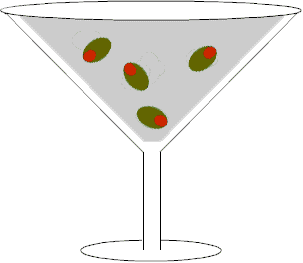Today, Martinis are usually made with vodka. However, they originally were made with gin. No one is sure when the drink was invented.
Ingredients:
![]() 1-3/4 oz Vodka – the best you can afford. I prefer Stoli.
1-3/4 oz Vodka – the best you can afford. I prefer Stoli.![]() 1/8 oz Dry Vermouth – I prefer Martini & Rossi
1/8 oz Dry Vermouth – I prefer Martini & Rossi![]() olives – I LOVE Blue Cheese Stuffed Olives
olives – I LOVE Blue Cheese Stuffed Olives
Preparation:
- Chill a scrupulously clean martini glass by filling with ice and water and set aside.
- Fill a shaker tin with ice.
- Add vermouth first and then vodka.
- Cap tin with mixing glass.
- Shake vigorously (to break off little shards of ice).
- Dump ice and water from martini glass.
- Strain liquor mixture into your properly chilled martini glass.
- Garnish with olives and SWING! 😉
Popular Variations:
- “Dirty” Martini: means to add olive juice in Step #3 (with the vodka and vermouth. This is how I prefer it.)
- Cosmopolitan: Prepare as above with equal parts of Vodka, Triple Sec, Lime Juice and JUST A SPLASH of Cranberry Juice. (It should just blush, like a young school girl).
- Gin Martini: Prepare as above, substituting Gin for Vodka.
- For more variations, try the Webtender website.
History:
Martini’s were originally made with gin, although no one is sure when the drink was invented. In the early 60’s, vodka became a popular variation which has persisted until today. Martini-drinkers are very particular about how their little slice of heaven is prepared. As such, it is the most frequently returned drink. Due to their high alcohol content, this is a costly mistake.*
Most are prepared “straight-up” (such as above), but can be served “on-the-rocks” (on ice). The term, “dry” means with just a dash of vermouth. “Perfect” means a dash each of Sweet and Dry Vermouth.
By 1922 the martini reached its most recognizable form in which London dry gin and dry vermouth are combined at a ratio of 2:1, stirred in a mixing glass with ice cubes, with the optional addition of orange or aromatic bitters, then strained into a chilled cocktail glass. Over time the generally expected garnish became the drinker’s choice of a green olive or a twist of lemon peel.
In the United States, the three-martini lunch or noontime three-martini is a leisurely, indulgent lunch enjoyed by businesspeople or lawyers. It is named from the common belief that many people in the above-mentioned professions have enough leisure time and wherewithal to consume more than one martini during the work day. The 3-martini lunch became particularly identified in popular culture with Madison Avenue advertising executives in the 1960s and 1970s, who supposedly became more creative after such lunchtime libations. I can’t imagine going back to the office and actually working.
*In all my years of bartending, I’ve only had 2 returned.

